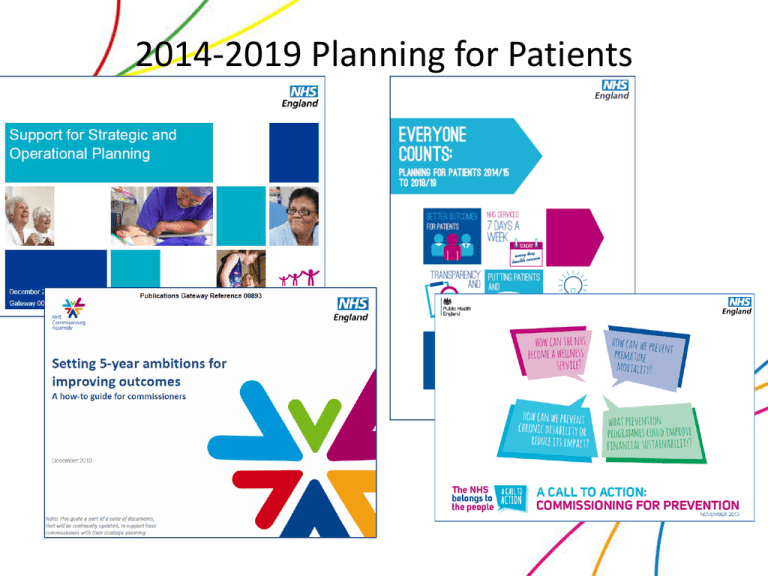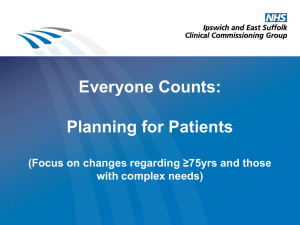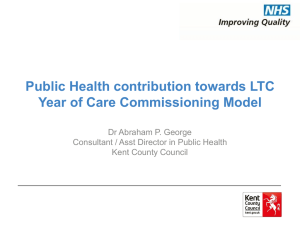Strategic Plan 2014/15 presentation
advertisement

2014-2019 Planning for Patients Strategic enablers Ambition Areas Strategic Objectives for the Local Health economy by 18/19 Reducing health inequalities Right size acute Confident panorganisational working Improving life expectancy at 65 and reducing the number of years spent with illness or disability Long term conditions Care plans in place with consequent reduction of in-patient bed days for LTCs OOH care with capacity and capability to deliver Financial sustainability of all providers Number of hospital episodes in final month of life and % dying in preferred place of death Non elective hospital spells for the over 75s Joint Commissioning and partnerships Out of Hospital Independent living No. Health or social care funded residential beds/ no people over 75 No Health or social care funded nursing beds / no people over 75 Children and Young People Improving the mental and emotional well being of children and younger people to reduce the incidence of challenging behaviour self harm & suicide and improving resilience among families Cancer Premature mortality rates, survival rates at 1 year and 5 years Patient experience of the cancer pathway, diagnosis by the emergency route Planned Care Right care, right time, irrespective of place End of life Frail Elderly Unscheduled Care Consistent high quality patient experience Dementia Diagnosis, patient and carer experience Parity of Esteem Empowering self management Controlled costs Co-ordinated and personalised service linked to planned care Accessibility: equal and appropriate for all users Improving health and social care outcomes (NHS Outcomes framework) Effective strategic and operational clinical leadership Competent compassionate workforce Local Ambition Area 2: Long term conditions • • • • King’s Fund intelligence indicates that patients with Long Term Conditions account for 70% of all in-patient bed days. In E&N Hertfordshire this amounts to 240,707 bed days. If a patient with a LTC condition has an actively managed care plan then the exacerbations of their condition should be better understood and managed by patients and carers themselves, appropriately accessing the right services. This means that exacerbations are less likely to result in a hospital admission . The CCG wants to encourage all patients with LTC to be supported with actively managed care plans and, as a consequence, to see the number of LTC bed days reduce to yyy,yyy. The secondary care providers do not always record which patients have long term conditions, so it is not straightforward for the CCG to track the percentage of bed days devoted to people with one or more LTC. However, the CCG is working with Trusts to find a sensible way to measure and track this important indicator. By 2016, 90% of patients with LTC will be offered a personal health care plan initiated by the most appropriate HCP and 50% will actually have a personal health plan, contributing to a reduction of hospital bed days for patients with LTC by xxx by 2019. The NHS England CCG Outcomes Tool shows that 75.8% of E&N Herts patients with LTCs “feel supported”. This is better than the average for England and better than the regional mean. The best in England scores 80%. By 2018/19 the CCG aims to have 80% of patients with LTCs feeling supported and be in the top decile for England. 2011/12 2012/13 2013/14 No in patient bed days for people with LTCs 248,779 241,714 240,707 All in patient bed days 355,399 345,305 343,867 % in patient bed days for people with LTCs 70 70 70 Patients feeling confidence to manage their condition 75.8% 2019 65 80% National Evidence for local ambition area 2 http://ccgtools.england.nhs.uk/ccgoutcomes/flash/atlas.html accessed on 20 March 2014 Links to National Outcome Ambitions. • This Local Ambition 2 relates to National Outcome Ambition 3: Reducing the time spent avoidably in hospital through better and more integrated care in the community outside of hospital – Unplanned hospitalisation for chronic ambulatory case sensitive conditions – Emergency admissions for acute conditions that should not normally require hospital admission Operationalising Local Ambition 2 Start date Finish date description Anticipated benefit COPD proactive case management March 2014 April 2016 Working with practices to review cases, admissions and to manage variation Reduce variation of exacerbations of COPD across localities. Stroke pathway redesign March 2014 October 2014 Commissioning a seamless care pathway form diagnoses to 6 month refer post stroke. 40% of stroke patient are discharged from hospital to their homes with effective support that increases their level of independence and patient experience. Redesigning the Diabetes pathway March 2014 April 2016 Developing a pathway that builds on the community care pathway - supporting patients with diabetes across primary and secondary care . Enhancing recovery and preventing diabetes associated complications. Implementing an integrated Heart failure pathway March 2014 August 2015 Review current pathway to support patients and carers to self manage and develop plans to manage changes in condition. Increased patient and carer satisfaction Reduced demand on secondary care Reduction in exacerbation. Patient Education Programmes March 2014 April 2019 Education programmes to enable patients to manage understand and manage their health and conditions Through patient stories, demonstrable improvements in patient experience. Local Ambition Area 7: Cancer • • • • We know that earlier diagnosis of cancer improves survival rates. More comprehensive cancer screening, better use of referral guidelines, reflective analysis of cancer cases, tighter safety-netting systems and lower thresholds for investigations (in line with national guidance) can all help in detecting cancers at an earlier stage when they are easier to treat with less morbidity and a higher likelihood of cure. In terms of survival rates for cancer for people aged under 75 the CCG is currently slightly below the England median and below the regional mean (according to the most recently available figures). The “Commissioning for Value” report indicates that cancer is an area where the CCG can make most significant quality improvements and it highlights colorectal cancer and breast cancer particularly as those where mortality rates can be improved. Mount Vernon Cancer Network has compiled a GP Practice profile analysis which shows a variation in GP practice. There is a problem with early diagnosis (in some practices) and some cancers are diagnosed in A&E. The CCG has three principals for designing its ambition in cancer: (i) achieve or exceed the national average in all measures; (ii) improve on year and not see any reduction in outcomes; (iii) all localities within 20% of the best performing locality. 2013/14 Locality variation range under 75 mortality from all cancers (per 100,000 population) 79 – 122 Practice variation range – cancer crude mortality rate (deaths per 100,000 population) 80 – 420 Breast cancer 1 year / 5 year survival rates (%) 97 / 86 Colorectal cancer 1 year / 5 year survival rates (%) 73 / 56 Patient experience of the cancer pathway % of cancer diagnoses via an emergency route (practice variation range) 3% 67% 2014/15 2015/16 2016/17 All localities within 35% of the best 2017/18 2018/19 All localities within 20% of the best No practice performing worse than 20% above the CCG mean Mount Vernon Cancer Network Practice Profile report 2012 Stort Valley and villages North Herts Summary statistics – emergency route diagnosis Summary statistics – emergency route diagnosis 2010 2011 England mean average 23.7% 23.8% CCG mean average 20.4% Locality practice min Locality practice max Practices within recommended range 1 2012 2010 2011 England mean average 23.7% 23.8% 20.9% CCG mean average 20.4% 20.9% 14.3% 10.5% Locality practice min 5.9% 10.9% 36.4% 42.9% Locality practice max 30.0% 30.8% 2(3) 3(5) 3(8) 3(11) 2010 2011 England mean average 23.7% 23.8% CCG mean average 20.4% 20.9% Practices within recommended range Stevenage 1 Welwyn Hatfield Summary statistics 2011 England mean average 23.7% 23.8% CCG mean average 20.4% 20.9% Locality practice min 0.0% 5.9% Locality practice min 15.4% 6.1% Locality practice max 47.2% 66.7% Locality practice max 25.9% 40.4% 1(5) 2(4) 3(7) 5(7) 2010 2011 England mean average 23.7% 23.8% CCG mean average 20.4% 20.9% Locality practice min 0.0% 12.5% 29.0% 34.6% 3(4) 1(6) 1 2012 Summary statistics 2010 Practices within recommended range 2012 Practices within recommended range Upper lea Valley Lower Lea Valley Summary statistics 2010 2011 England mean average 23.7% 23.8% CCG mean average 20.4% 20.9% Locality practice min 3.1% 3.3% Locality practice max 29.6% 41.7% 4(7) 6(10) Practices below recommended range 1 2012 1 2012 Summary statistics Locality practice max Practices within recommended range 1 2012 Operationalising the ambition Start date Improving cancer variation Finish date description Anticipated benefit The CCG aims to make a positive difference to the people of East and North Hertfordshire by empowering them to live well and as healthily as possible. We will engage the public and health &social care colleagues to design a person centred service that we are proud to deliver and pleased to receive. We will work together to develop, commission and evaluate new ways of service, making best use of resources. Commissioning for Quality We are committed to ensuring that the quality of services and clinical outcomes for our patients are continuously improved in line with the principles and values of the NHS constitution and the recommendations of the Francis Inquiry. • Effectiveness of the treatment and care provided– according to best evidence and measured by both clinical outcomes and patient related outcomes • Safety of the treatment and care provided avoiding all avoidable harm and risks to patient safety. • Experience patients have of the treatment and care provided - being treated with compassion, dignity and respect. Commissioning for Outcomes Our overarching aim is to improve the health of the population to reduce health need and to find better ways of commissioning high quality services at lower cost. This will include investing money in community and primary care to develop services focusing on long term conditions and our ageing population. Healthy Living - Reducing the harm caused by alcohol; Reducing the harm from tobacco; Increasing physical activity and promoting a healthy weight. Independent Lives - Fulfilling lives for people with learning disabilities; Living well with dementia; Enhancing quality of life for people with long term conditions. Flourishing Communities - Supporting carers to care; Helping all families to thrive; Improving mental health and emotional wellbeing Building system transformation on what we can prove works well in our area With a foundation of strong commissioning and a stable health economy, the CCG actively pursues innovation to build improvements in health and social care services to improve health outcomes Home First is demonstrating strong quality outcomes and moving care closer to home Values and Principles • Having a clinical focus in everything we do; • Be clear about improvements we want to see in every service we commission; • Include patients in our commissioning discussions; • Tackle variation and inequalities; • Work collaboratively with our partners to commission integrated care for our patients; • Be accountable for the decisions we make; • Improve outcomes for our patients; • Show commitment to working transparently and openly; • Abide by the standards in Public Life; • Listen to the clinical voice. Sustainable, integrated services suited to the patient • Right size acute care consolidated at the Lister site, the new QEII functioning effectively and neighbouring acute trusts will be clinically and financially sustainable, delivering high quality care. • Out of Hospital care with capacity and capability to deliver • Effective strategic and operational clinical leadership resulting in confident panorganisational working operational clinical leadership from a competent compassionate and dedicated workforce Building clinical leadership at all levels Building services around the patient requires closer integration of health and social care Improving the use of care planning will empower patients and carers to manage their conditions and make more appropriate use of services. Community Care Developing integrated pathways centred on patient need requires pan-organisational working Governance Acute Care The CCG has a federated model which puts GPs at the forefront of designing and leading the future health economy. Perception Trust Capacity Capability The CCG uses clinical networks to ensure that all clinical perspectives are fully consulted in the design and delivery of services. Social Care Primary Care Views from patients, carers and the public are at the heart of decision making. Outcomes • Improving life expectancy at 65 • Improving disability free life expectancy at 65 • Reducing hospital episodes for people with Long term conditions • Improving the quality of care for people at the end of life • Reducing emergency admissions for people over 75 • More people living independently • Increased survival rates from cancer • Improving emotional and mental wellbeing of children



